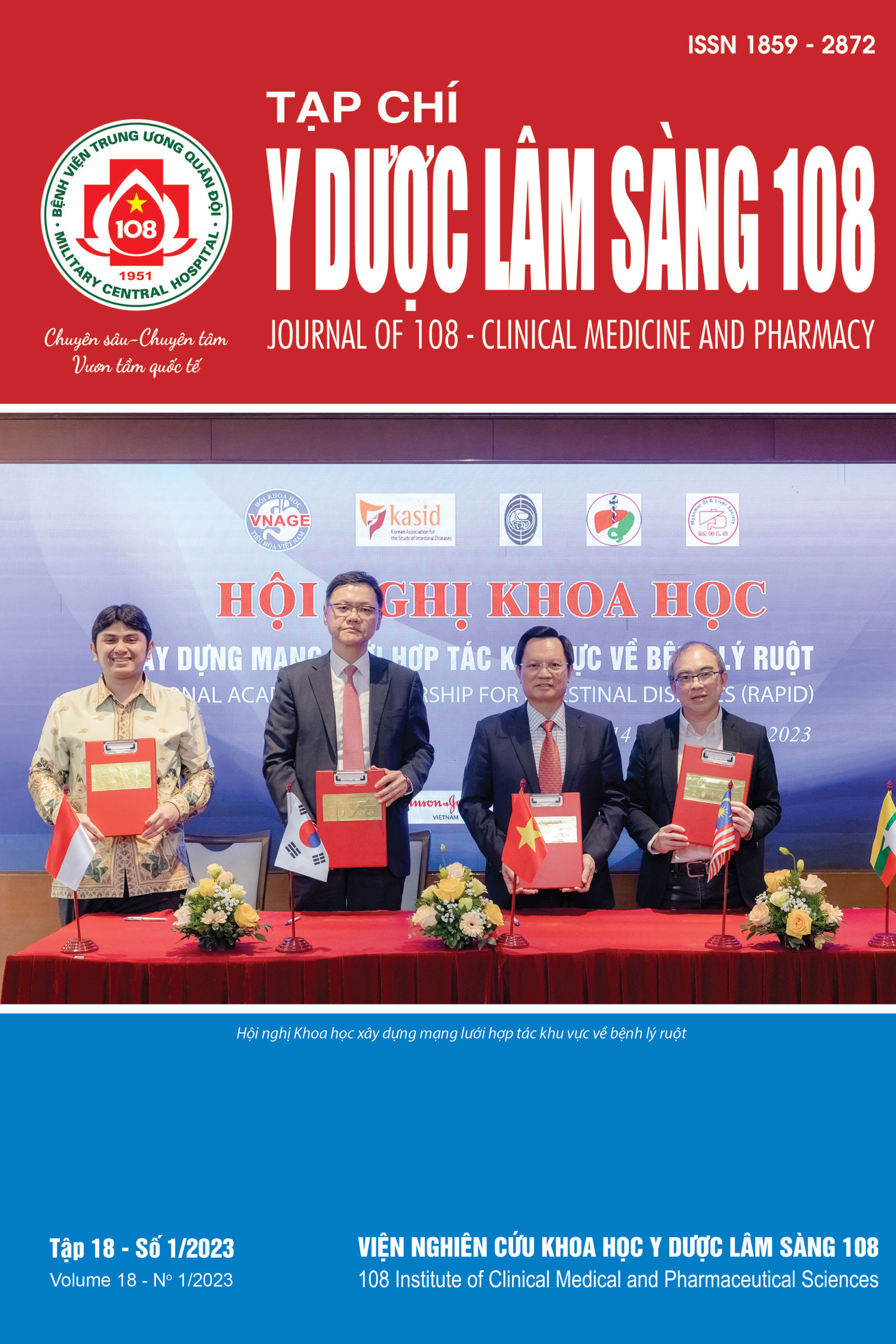Evaluation of exercise capacity in heart failure with preserved ejection fraction patients by the exercise treadmill test
Main Article Content
Keywords
Abstract
Objective: To evaluate the exercise capacity of patients with heart failure with preserved ejection fraction by mobility exercise with running mats. Subject and method: Assessing changes in heart rate, exercise intensity, and maximal oxygen consumption during and after exercise in 50 patients diagnosed with preserved ejection fraction heart failure at the Vietnam Heart Institute - Bach Mai Hospital. Result: Mean age was 50 ± 13.9 years (24-71 years). Baseline mean left ventricular ejection fraction was 56.6 ± 3.2% and the exercise on the running mat for a mean time of 1041 ± 318 seconds. The results showed that the mean exercise level of the patients was 13.0 ± 3.9 (METs) and maximum oxygen consumption VO2max of 62.3 ± 19.9 (ml/kg/min). After exercise, the heart rate recovery value after 1 minute was 29.6 ± 14.5 (beats/min). Exercise capacity was correlated with heart rate recovery value with r = 0.436 (p<0.05). Conclusion: Heart rate recovery value of Vietnamese subjects with heart failure preserved ejection fraction after exercise 1 minute was positively correlated with METS exercise capacity. There was no correlation between the heart rate recovery value and other factors such as gender, ejection fraction and maximal oxygen consumption.
Article Details
References
2. Nguyễn Thị Thu Hoài, Phan Đình Phong, Phạm Mạnh Hùng (2019) Nghiên cứu khả năng dung nạp với gắng sức ở các bệnh nhân đái tháo đường type 2 bằng phương pháp điện tâm đồ gắng sức thảm chạy. Tạp chí Tim mạch học Việt Nam số 86; 2019, tr. 97-103.
3. Nguyễn Đỗ Quân, Lê Đình Tùng (2020) Đặc điểm phục hồi nhịp tim sau bài tập vận cơ tĩnh và động ở người bình thường và ở bệnh nhân suy tim. Luận văn Thạc sĩ y học, Trường Đại học Y Hà Nội.
4. Buch AN, Coote JH, Townend JN (2002) Cardiac vagal control and physical training-what’s the link? Exp Physiol 87: 423-435.
5. Gerritsen J, Dekker JM, Tenvoorde BJ et al (2001) Impaired autonomic function is associated with increased mortality, especially in subjects with diabetes, hypertension, or a history of cardiovascular disease: The hoorn study. Diabetes Care 24(10): 1793-1798. doi: 10.2337/diacare.24.10.1793.
6. Sacre JW, Jellis C, Coombes J, Marwick T (2012) Diagnostic accuracy of heart-rate recovery after exercise in the assessment of diabetic cardiac autonomic neuropathy. Diabet Med 29: 312-320.
7. Buchheit M, Papelier Y, Laursen PB, Ahmaidi S (2007) Noninvasive assessment of cardiac parasympathetic function: Postexercise heart rate recovery or heart rate variability? Physiol Heart Circ Physiol 293: 8-10.
8. Morshedi-Meibodi A, Larson MG, Levy D, O'Donnell CJ, Vasan RS (2002) Heart rate recovery after treadmill exercise testing and risk of cardiovascular disease events (The Framingham Heart Study). Am J Cardiol 90: 848-852.
9. Racine N, Blanchet M, Ducharme A et al (2003) Decreased heart rate recovery after exercise in patients with congestive heart failure: Effect of beta-blocker therapy. J Card Fail 9: 296-302.
10. Ba A, Delliaux S, Bregeon F, Levy S, Jammes Y (2009) Post-exercise heart rate recovery in healthy, obeses, and COPD subjects: Relationships with blood lactic acid and PaO2 levels. Clin Res Cardiol 98: 52-58.
11. McDonagh TA, Metra M, Adamo M et al (2021) 2021 ESC Guidelines for the diagnosis and treatment of acute and chronic heart failure. European Heart Journal 12 (36): 3599-3726.
12. Lang RM, Badano LP, Mor-Avi V (2015) Recommendations for Cardiac Chamber Quantification by Echocardiography in Adults: An Update from the American Society of Echocardiography and the European Association of Cardiovascular Imaging. J Am Soc Echocardiogr 28: 1-39.
13. Nagueh S, Smiseth OA, Appleton CP (2016) Recommendations for the Evaluation of Left Ventricular Diastolic Function by Echocardiography: An Update from the American Society of Echocardiography and the European Association of Cardiovascular Imaging. J Am Soc Echocardiogr 29: 277-314.
14. Erdogan D, Gonul E, Icli A et al (2011) Effects of normal blood pressure, prehypertension, and hypertension on autonomic nervous system function. Int J Cardiol 151: 50-53.
15. Cole CR, Foody JM, Blackstone EH, Lauer MS (2000) Heart rate recovery after submaximal exercise testing as a predictor of mortality in a cardiovascularly healthy cohort. Ann Intern Med 132: 552-555.
16. Vivekananthan DP, Blackstone EH, Pothier CE, Lauer MS (2003) Heart rate recovery after exercise is a predictor of mortality, independent of the angiographic severity of coronary disease. J Am Coll Cardiol 42: 831-838.
17. Kaye DM, Esler MD (2008) Autonomic control of the aging heart. Neuromolecular Med 10: 179-186.
 ISSN: 1859 - 2872
ISSN: 1859 - 2872
